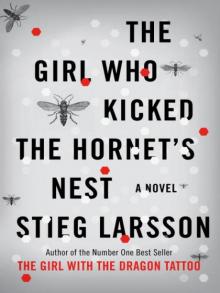- Home
- Stieg Larsson
The Girl With the Dragon Tattoo Trilogy Bundle
The Girl With the Dragon Tattoo Trilogy Bundle Read online
A VINTAGE CRIME/BLACK LIZARD EBOOK EDITION
The Girl With the Dragon Tattoo translation copyright © 2008 by Reg Keeland
The Girl Who Played With Fire translation copyright © 2009 by Reg Keeland
The Girl Who Kicked the Hornet’s Nest translation copyright © 2009 by Reg Keeland
All rights reserved. The novels contained in this omnibus were each published separately in the United States by Vintage Books, a division of Random House, Inc., New York. The Girl with the Dragon Tattoo was originally published as Man Som Hatar Kvinnor by Norstedts, Stockholm, in 2005. Published with agreement of Norstedts Agency. Copyright © 2005 by Norstedts Agency. The Girl Who Played with Fire was originally published as Flickan Som Lekte Med Elden by Norstedts, Stockholm, in 2006. Copyright © 2005 by Norstedts Agency. The Girl Who Kicked the Hornet’s Nest was originally published as Luftslottet Som Sprangdes by Norstedts, Stockholm, in 2007. Copyright © 2007 by Norstedts Agency. These translations were originally published in Great Britain by MacLehose Press, an imprint of Quercus, London, with agreement of Norstedts Agency, in 2008 and 2009, and in the United States by Alfred A. Knopf, a division of Random House, Inc., New York, in 2008, 2009, and 2010. Published by arrangement with Quercus Publishing PLC (UK).
Vintage is a registered trademark and Vintage Crime/Black Lizard and colophon are trademarks of Random House, Inc.
The Girl With the Dragon Tattoo, The Girl Who Played With Fire, and The Girl Who Kicked the Hornet’s Nest are works of fiction. Names, characters, places, and incidents either are the product of the author’s imagination or are used fictitiously. Any resemblance to actual persons, living or dead, events, or locales is entirely coincidental.
Vintage eISBN: 978-0-307-95063-5
Cover design by Peter Quach
www.vintagebooks.com
v3.1
Contents
Cover
Title Page
Copyright
THE GIRL WITH THE DRAGON TATTOO
THE GIRL WHO PLAYED WITH FIRE
THE GIRL WHO KICKED THE HORNET’S NEST
THIS IS A BORZOI BOOK
PUBLISHED BY ALFRED A. KNOPF
Translation copyright © 2008 by Reg Keeland
All rights reserved. Published in the United States by Alfred A. Knopf, a division of Random House, Inc., New York.
www.aaknopf.com
Originally published in Sweden as Män Som Hatar Kvinnor by Norstedts, Stockholm, in 2005. Published with agreement of Norstedts Agency. Copyright © 2005 by Norstedts Agency. This translation originally published in Great Britain by MacLehose Press, an imprint of Quercus, London. Published by arrangement with Quercus Publishing PLC (UK).
Knopf, Borzoi Books, and the colophon are registered trademarks of Random House, Inc.
Library of Congress Cataloging-in-Publication Data
Larsson, Stieg, 1954–2004.
[Män som hatar kvinnor. English]
The Girl with the dragon tattoo / by Stieg Larsson; translated from the Swedish by Reg Keeland.
—1st American ed.
p. cm.
Originally published: Stockholm: Norstedt, 2005.
eISBN: 978-0-307-27211-9
I. Title.
PT9876.22.A6933M36 2008
839.73'8—dc22 2008017771
This is a work of fiction. Names, characters, places, and incidents either are the product of the author’s imagination or are used fictiously. Any resemblance to actual persons, living or dead, events, or locales is entirely coincidental.
eISBN: 978-0-307-27211-9
Cover design by Peter Mendelsund
v3.0_r3
Contents
Cover
Title Page
Copyright
Prologue: A Friday in November
The Vanger Family Tree
Part 1 Incentive
Chapter 1 Friday, December 20
Chapter 2 Friday, December 20
Chapter 3 Friday, December 20–Saturday, December 21
Chapter 4 Monday, December 23–Thursday, December 26
Chapter 5 Thursday, December 26
Chapter 6 Thursday, December 26
Chapter 7 Friday, January 3
Part 2 Consequence Analyses
Chapter 8 Friday, January 3–Sunday, January 5
Chapter 9 Monday, January 6–Wednesday, January 8
Chapter 10 Thursday, January 9–Friday, January 31
Chapter 11 Saturday, February 1–Tuesday, February 18
Chapter 12 Wednesday, February 19
Chapter 13 Thursday, February 20–Friday, March 7
Chapter 14 Saturday, March 8–Monday, March 17
Part 3 Mergers
Chapter 15 Friday, May 16–Saturday, May 31
Chapter 16 Sunday, June 1–Tuesday, June 10
Chapter 17 Wednesday, June 11–Saturday, June 14
Chapter 18 Wednesday, June 18
Chapter 19 Thursday, June 19–Sunday, June 29
Chapter 20 Tuesday, July 1–Wednesday, July 2
Chapter 21 Thursday, July 3–Thursday, July 10
Chapter 22 Thursday, July 10
Chapter 23 Friday, July 11
Part 4 Hostile Takeover
Chapter 24 Friday, July 11–Saturday, July 12
Chapter 25 Saturday, July 12–Monday, July 14
Chapter 26 Tuesday, July 15–Thursday, July 17
Chapter 27 Saturday, July 26–Monday, July 28
Chapter 28 Tuesday, July 29–Friday, October 24
Chapter 29 Saturday, November 1–Tuesday, November 25
Epilogue: Final Audit Thursday, November 27–Tuesday, December 30
PROLOGUE
A Friday in November
It happened every year, was almost a ritual. And this was his eighty-second birthday. When, as usual, the flower was delivered, he took off the wrapping paper and then picked up the telephone to call Detective Superintendent Morell who, when he retired, had moved to Lake Siljan in Dalarna. They were not only the same age, they had been born on the same day—which was something of an irony under the circumstances. The old policeman was sitting with his coffee, waiting, expecting the call.
“It arrived.”
“What is it this year?”
“I don’t know what kind it is. I’ll have to get someone to tell me what it is. It’s white.”
“No letter, I suppose.”
“Just the flower. The frame is the same kind as last year. One of those do-it-yourself ones.”
“Postmark?”
“Stockholm.”
“Handwriting?”
“Same as always, all in capitals. Upright, neat lettering.”
With that, the subject was exhausted, and not another word was exchanged for almost a minute. The retired policeman leaned back in his kitchen chair and drew on his pipe. He knew he was no longer expected to come up with a pithy comment or any sharp question which would shed a new light on the case. Those days had long since passed, and the exchange between the two men seemed like a ritual attaching to a mystery which no-one else in the whole world had the least interest in unravelling.
The Latin name was Leptospermum (Myrtaceae) rubinette. It was a plant about four inches high with small, heather-like foliage and a white flower with five petals about one inch across.
The plant was native to the Australian bush and uplands, where it was to be found among tussocks of grass. There it was called Desert Snow. Someone at the botanical gardens in Uppsala would later confirm that it was a plant seldom cultivated in Sweden. The botanist wrote in her report that it was related to the tea tree and that it was sometimes confused with its more comm
on cousin Leptospermum scoparium, which grew in abundance in New Zealand. What distinguished them, she pointed out, was that rubinette had a small number of microscopic pink dots at the tips of the petals, giving the flower a faint pinkish tinge.
Rubinette was altogether an unpretentious flower. It had no known medicinal properties, and it could not induce hallucinatory experiences. It was neither edible, nor had a use in the manufacture of plant dyes. On the other hand, the aboriginal people of Australia regarded as sacred the region and the flora around Ayers Rock.
The botanist said that she herself had never seen one before, but after consulting her colleagues she was to report that attempts had been made to introduce the plant at a nursery in Göteborg, and that it might, of course, be cultivated by amateur botanists. It was difficult to grow in Sweden because it thrived in a dry climate and had to remain indoors half of the year. It would not thrive in calcareous soil and it had to be watered from below. It needed pampering.
The fact of its being so rare a flower ought to have made it easier to trace the source of this particular specimen, but in practice it was an impossible task. There was no registry to look it up in, no licences to explore. Anywhere from a handful to a few hundred enthusiasts could have had access to seeds or plants. And those could have changed hands between friends or been bought by mail order from anywhere in Europe, anywhere in the Antipodes.
But it was only one in the series of mystifying flowers that each year arrived by post on the first day of November. They were always beautiful and for the most part rare flowers, always pressed, mounted on water-colour paper in a simple frame measuring six inches by eleven inches.
The strange story of the flowers had never been reported in the press; only a very few people knew of it. Thirty years ago the regular arrival of the flower was the object of much scrutiny—at the National Forensic Laboratory, among fingerprint experts, graphologists, criminal investigators, and one or two relatives and friends of the recipient. Now the actors in the drama were but three: the elderly birthday boy, the retired police detective, and the person who had posted the flower. The first two at least had reached such an age that the group of interested parties would soon be further diminished.
The policeman was a hardened veteran. He would never forget his first case, in which he had had to take into custody a violent and appallingly drunk worker at an electrical substation before he caused others harm. During his career he had brought in poachers, wife beaters, con men, car thieves, and drunk drivers. He had dealt with burglars, drug dealers, rapists, and one deranged bomber. He had been involved in nine murder or manslaughter cases. In five of these the murderer had called the police himself and, full of remorse, confessed to having killed his wife or brother or some other relative. Two others were solved within a few days. Another required the assistance of the National Criminal Police and took two years.
The ninth case was solved to the police’s satisfaction, which is to say that they knew who the murderer was, but because the evidence was so insubstantial the public prosecutor decided not to proceed with the case. To the detective superintendent’s dismay, the statute of limitations eventually put an end to the matter. But all in all he could look back on an impressive career.
He was anything but pleased.
For the detective, the “Case of the Pressed Flowers” had been nagging at him for years—his last, unsolved, and frustrating case. The situation was doubly absurd because after spending literally thousands of hours brooding, on duty and off, he could not say beyond doubt that a crime had indeed been committed.
The two men knew that whoever had mounted the flowers would have worn gloves, that there would be no fingerprints on the frame or the glass. The frame could have been bought in camera shops or stationery stores the world over. There was, quite simply, no lead to follow. Most often the parcel was posted in Stockholm, but three times from London, twice from Paris, twice from Copenhagen, once from Madrid, once from Bonn, and once from Pensacola, Florida. The detective superintendent had had to look it up in an atlas.
After putting down the telephone the eighty-two-year-old birthday boy sat for a long time looking at the pretty but meaningless flower whose name he did not yet know. Then he looked up at the wall above his desk. There hung forty-three pressed flowers in their frames. Four rows of ten, and one at the bottom with four. In the top row one was missing from the ninth slot. Desert Snow would be number forty-four.
Without warning he began to weep. He surprised himself with this sudden burst of emotion after almost forty years.
PART 1
Incentive
DECEMBER 20–JANUARY 3
Eighteen percent of the women in Sweden have at one time been threatened by a man.
CHAPTER 1
Friday, December 20
The trial was irretrievably over; everything that could be said had been said, but he had never doubted that he would lose. The written verdict was handed down at 10:00 on Friday morning, and all that remained was a summing up from the reporters waiting in the corridor outside the district court.
“Carl” Mikael Blomkvist saw them through the doorway and slowed his step. He had no wish to discuss the verdict, but questions were unavoidable, and he—of all people—knew that they had to be asked and answered. This is how it is to be a criminal, he thought. On the other side of the microphone. He straightened up and tried to smile. The reporters gave him friendly, almost embarrassed greetings.
“Let’s see … Aftonbladet, Expressen, TT wire service, TV4, and … where are you from? … ah yes, Dagens Nyheter. I must be a celebrity,” Blomkvist said.
“Give us a sound bite, Kalle Blomkvist.” It was a reporter from one of the evening papers.
Blomkvist, hearing the nickname, forced himself as always not to roll his eyes. Once, when he was twenty-three and had just started his first summer job as a journalist, Blomkvist had chanced upon a gang which had pulled off five bank robberies over the past two years. There was no doubt that it was the same gang in every instance. Their trademark was to hold up two banks at a time with military precision. They wore masks from Disney World, so inevitably police logic dubbed them the Donald Duck Gang. The newspapers renamed them the Bear Gang, which sounded more sinister, more appropriate to the fact that on two occasions they had recklessly fired warning shots and threatened curious passersby.
Their sixth outing was at a bank in Östergötland at the height of the holiday season. A reporter from the local radio station happened to be in the bank at the time. As soon as the robbers were gone he went to a public telephone and dictated his story for live broadcast.
Blomkvist was spending several days with a girlfriend at her parents’ summer cabin near Katrineholm. Exactly why he made the connection he could not explain, even to the police, but as he was listening to the news report he remembered a group of four men in a summer cabin a few hundred feet down the road. He had seen them playing badminton out in the yard: four blond, athletic types in shorts with their shirts off. They were obviously bodybuilders, and there had been something about them that had made him look twice—maybe it was because the game was being played in blazing sunshine with what he recognised as intensely focused energy.
There had been no good reason to suspect them of being the bank robbers, but nevertheless he had gone to a hill overlooking their cabin. It seemed empty. It was about forty minutes before a Volvo drove up and parked in the yard. The young men got out, in a hurry, and were each carrying a sports bag, so they might have been doing nothing more than coming back from a swim. But one of them returned to the car and took out from the boot something which he hurriedly covered with his jacket. Even from Blomkvist’s relatively distant observation post he could tell that it was a good old AK4, the rifle that had been his constant companion for the year of his military service.
He called the police and that was the start of a three-day siege of the cabin, blanket coverage by the media, with Blomkvist in a front-row seat and collecting a gratifyingly l
arge fee from an evening paper. The police set up their headquarters in a caravan in the garden of the cabin where Blomkvist was staying.
The fall of the Bear Gang gave him the star billing that launched him as a young journalist. The downside of his celebrity was that the other evening newspaper could not resist using the headline “Kalle Blomkvist solves the case.” The tongue-in-cheek story was written by an older female columnist and contained references to the young detective in Astrid Lindgren’s books for children. To make matters worse, the paper had run the story with a grainy photograph of Blomkvist with his mouth half open even as he raised an index finger to point.
It made no difference that Blomkvist had never in life used the name Carl. From that moment on, to his dismay, he was nicknamed Kalle Blomkvist by his peers—an epithet employed with taunting provocation, not unfriendly but not really friendly either. In spite of his respect for Astrid Lindgren—whose books he loved—he detested the nickname. It took him several years and far weightier journalistic successes before the nickname began to fade, but he still cringed if ever the name was used in his hearing.
Right now he achieved a placid smile and said to the reporter from the evening paper: “Oh come on, think of something yourself. You usually do.”
His tone was not unpleasant. They all knew each other, more or less, and Blomkvist’s most vicious critics had not come that morning. One of the journalists there had at one time worked with him. And at a party some years ago he had nearly succeeded in picking up one of the reporters—the woman from She on TV4.
“You took a real hit in there today,” said the one from Dagens Nyheter, clearly a young part-timer. “How does it feel?”

 The Girl with the Dragon Tattoo
The Girl with the Dragon Tattoo The Girl Who Kicked the Hornet's Nest
The Girl Who Kicked the Hornet's Nest The Girl Who Played with Fire
The Girl Who Played with Fire The Girl with the Dragon Tattoo m(-1
The Girl with the Dragon Tattoo m(-1 The Girl who played with Fire m(-2
The Girl who played with Fire m(-2 Millennium 01 - The Girl with the Dragon Tattoo
Millennium 01 - The Girl with the Dragon Tattoo The Girl Who Kicked The Hornets’ Nest m(-3
The Girl Who Kicked The Hornets’ Nest m(-3 Millennium 02 - The Girl Who Played with Fire
Millennium 02 - The Girl Who Played with Fire Millennium 03 - The Girl Who Kicked the Hornet's Nest
Millennium 03 - The Girl Who Kicked the Hornet's Nest The Girl With the Dragon Tattoo Trilogy Bundle
The Girl With the Dragon Tattoo Trilogy Bundle![Millenium [02] The Girl Who Played With Fire Read online](http://i1.bookreadfree.com/i2/04/12/millenium_02_the_girl_who_played_with_fire_preview.jpg) Millenium [02] The Girl Who Played With Fire
Millenium [02] The Girl Who Played With Fire